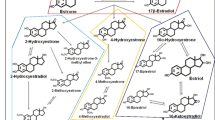Abstract
The estrogen receptor concentrations in the cervical myometrium and ectocervical and vaginal epithelium were very low soon after the menstrual bleeding. The receptor concentrations were considerably higher in the middle of the proliferative phase and in postmenopausal patients treated with vaginal estrogens. In these two groups the estrogen receptor concentrations were lowest in the vaginal epithelium and highest in the cervical myometrium. In all three tissues studied, estradiol had the highest affinity to the receptor protein, followed by estriol and estrone. The binding was specific for all three estrogens whereas a 1000-fold excess of progesterone, dihydrotestosteroneand testosterone was required in order to obtain competition for the estrogen receptor. Sedimentation analysis showed that estriol and estradiol were bound to macromolecules sedimenting at 9.0 S and 3.5–4.6 S whereas estrone was bound only to the 4.6 S binding protein.
Similar content being viewed by others
References
Sanborn B.M., Held B., Hsue S.T. Specific estrogen binding proteins in human cervix. J. Steroid Biochem. 6: 1107, 1975.
Odeblad E., Rudolfsson C. The biology of the cervix. University of Chicago Press, Chicago, 1973, p. 267.
Rosner J.M., Martinez I.M., Mendizabal A.F., Spaltro N.A. The in vivo and in vitro uptake of labelled estradiol by different segments of the human uterus. Steroidologia 2: 283, 1971.
Puck A., Korte W., Hubner K.A. Die Wirkung des Oestriol auf Corpus Uteri, Cervix Uteri und Vagina der Frau. Dtsch. Med. Wochenschr. 82: 1864, 1957.
Tzingounis V.A., Aksu M.F., Greenblatt R.B. Oestriol in the management of the menopause. JAMA 239: 1638, 1978.
Lowry O.H., Rosebrough N.J., Farr A.L., Randall R.J. Protein measurement with the folin phenol reagent. J. Biol. Chem. 193: 265, 1951.
Scatchard G. The attractions of proteins for small molecules and ions. Ann. N.Y. Acad. Sci. 57: 660, 1949.
Lövgren T., Pettersson K., Kouvonen I., Punnonen R. Binding characteristics of estrone, estradiol and estriol to the human myometrial estrogen receptor. J. Steroid Biochem. 9: 803, 1978.
Hähnel R., Twaddle E., Ratajczak T. The specificity of the estrogen receptor of human uterus. J. Steroid Biochem. 4: 21, 1973.
Brecher P.J., Wotiz H.H. Competition between estradiol and estriol for end organ receptor proteins. Steroids 9: 431, 1967.
Koreman S.G. Comparative binding affinity of estrogens and its relation to estrogenic potency. Steroids 13: 163, 1969.
Lukola A., Lövgren T., Punnonen R. Nuclear binding of estradiol in human myometrium. J. Steroid Biochem. 13: 1241, 1980.
Jungblut P.W., Hughes A., Ganes J., Kallweit E., Maschler I., Pari F., Sierrata W., Szendro P.I., Wagner R.K. Mechanism involved in the regulation of steroid receptor levels. J. Steroid Biochem. 11: 273, 1979.
Korach K., Fox-Davies C., Baker V. Differential response to estriol and estradiol in the mouse uterus: Correlation to an additional nuclear event. Endocrinology 106: 1900, 1980.
Haskins A.L., Moszkowski E.F., Whitelock V.P. The estrogenic potential of estriol. Am. J. Obstet. Gynecol. 102: 665, 1968.
Englund A., Johansson D. Endometrial effect of oral estriol treatment in postmenopausal women. Acta Obstet. Gynecol. Scand. 59: 449, 1980.
Robertson D.M., Mester J., Beilby J., Steele D.J., Kellie A.E. The measurement of high-affinity estradiol receptors in human uterine endometrium and myometrium. Acta Endocrinol. (Kbh.) 68: 534, 1971.
Wiegerinck M.A.H.M., Poortman J., Agema A.R., Thjissen J.H.H. Estrogen receptors in human vaginal tissue. Maturitas 2: 59, 1980.
Stumpf W., Baerwaldt C., Sar M. Basic action of sex steroids on target organs. Karger, Basel, 1971, p. 3.
Payne W.D., Katzenellenbogen J.A. Differential effects of estrogens in tissues: A comparison of estrogen receptor in rabbit uterus and vagina. Endocrinology 706: 1345, 1980.
Author information
Authors and Affiliations
Rights and permissions
About this article
Cite this article
Punnonen, R., Lukola, A. High-affinity binding of estrone, estradiol and estriol in human cervical myometrium and cervical and vaginal epithelium. J Endocrinol Invest 5, 203–207 (1982). https://doi.org/10.1007/BF03348324
Received:
Accepted:
Published:
Issue Date:
DOI: https://doi.org/10.1007/BF03348324




